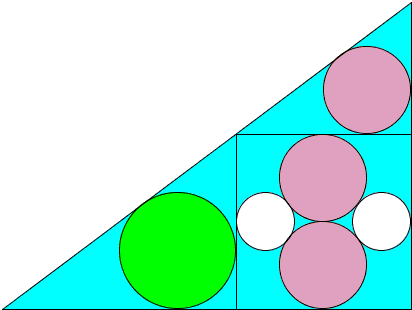3-4-5 Triangle by a Kid
It is often said that the practice of hanging sangaku was so common that even women and children took part in that activity. While there is a reasonable doubt as to the popularity of sangaku, there is no question that some were hung by very young children. The one below was proposed by Sato Naosue, age thirteen, and hung in 1847 in the Akahagi Kannon temple in Ichinoseki city.

Two pink circles of radius $r$ and two white circles of radius $t$ are inscribed in a square, as shown. The square itself is inscribed in a large triangle and, as illustrated, two circles of radii $r$ and $R$ are inscribed in the small triangles outside the square. Show that $R = 2t$.
References
- H. Fukagawa, A. Rothman, Sacred Mathematics: Japanese Temple Geometry, Princeton University Press, 2008, pp. 104-105
Sangaku
- Sangaku: Reflections on the Phenomenon
- Critique of My View and a Response
- 1 + 27 = 12 + 16 Sangaku
- 3-4-5 Triangle by a Kid
- 7 = 2 + 5 Sangaku
- A 49th Degree Challenge
- A Geometric Mean Sangaku
- A Hard but Important Sangaku
- A Restored Sangaku Problem
- A Sangaku: Two Unrelated Circles
- A Sangaku by a Teen
- A Sangaku Follow-Up on an Archimedes' Lemma
- A Sangaku with an Egyptian Attachment
- A Sangaku with Many Circles and Some
- A Sushi Morsel
- An Old Japanese Theorem
- Archimedes Twins in the Edo Period
- Arithmetic Mean Sangaku
- Bottema Shatters Japan's Seclusion
- Chain of Circles on a Chord
- Circles and Semicircles in Rectangle
- Circles in a Circular Segment
- Circles Lined on the Legs of a Right Triangle
- Equal Incircles Theorem
- Equilateral Triangle, Straight Line and Tangent Circles
- Equilateral Triangles and Incircles in a Square
- Five Incircles in a Square
- Four Hinged Squares
- Four Incircles in Equilateral Triangle
- Gion Shrine Problem
- Harmonic Mean Sangaku
- Heron's Problem
- In the Wasan Spirit
- Incenters in Cyclic Quadrilateral
- Japanese Art and Mathematics
- Malfatti's Problem
- Maximal Properties of the Pythagorean Relation
- Neuberg Sangaku
- Out of Pentagon Sangaku
- Peacock Tail Sangaku
- Pentagon Proportions Sangaku
- Proportions in Square
- Pythagoras and Vecten Break Japan's Isolation
- Radius of a Circle by Paper Folding
- Review of Sacred Mathematics
- Sangaku à la V. Thebault
- Sangaku and The Egyptian Triangle
- Sangaku in a Square
- Sangaku Iterations, Is it Wasan?
- Sangaku with 8 Circles
- Sangaku with Angle between a Tangent and a Chord
- Sangaku with Quadratic Optimization
- Sangaku with Three Mixtilinear Circles
- Sangaku with Versines
- Sangakus with a Mixtilinear Circle
- Sequences of Touching Circles
- Square and Circle in a Gothic Cupola
- Steiner's Sangaku
- Tangent Circles and an Isosceles Triangle
- The Squinting Eyes Theorem
- Three Incircles In a Right Triangle
- Three Squares and Two Ellipses
- Three Tangent Circles Sangaku
- Triangles, Squares and Areas from Temple Geometry
- Two Arbelos, Two Chains
- Two Circles in an Angle
- Two Sangaku with Equal Incircles
- Another Sangaku in Square
- Sangaku via Peru
- FJG Capitan's Sangaku
|Contact| |Front page| |Contents| |Geometry| |Up|
Copyright © 1996-2018 Alexander Bogomolny

Obviously, the side of the square is of length $4r.$ One application of the Pythagorean theorem (in the dashed triangle) shows that $r = 3t/2.$ Use the Pythagorean theorem again in the small upper triangle:
Let $a$ be the small length of that triangle and $c$ its hypotenuse. On the other hand, the area $S$ of the small triangle can be computed in two ways:
$2S=r(a+c+4r)=4r\cdot a,$
such that $a+c+4r=4a;$ from which $c=3a-4r.$ Substitute that into the Pythagorean identity - $a^2+(4r)^2=c^2$ - to get the equation
$a^2+16r^2=(3a-4r)^2,$
solving which gives $a=3r.$
It may come as a surprise that the triangle turns out to be the famous 3-4-5 or Egyptian triangle with the short side equal to $3r.$ From the similarity of the three triangles, all of them have the proportions 3-4-5 which leads to $4r = 3R.$ And finally, $R = 4r/3 = 2t.$
|Contact| |Front page| |Contents| |Geometry| |Up|
Copyright © 1996-2018 Alexander Bogomolny
73581898
